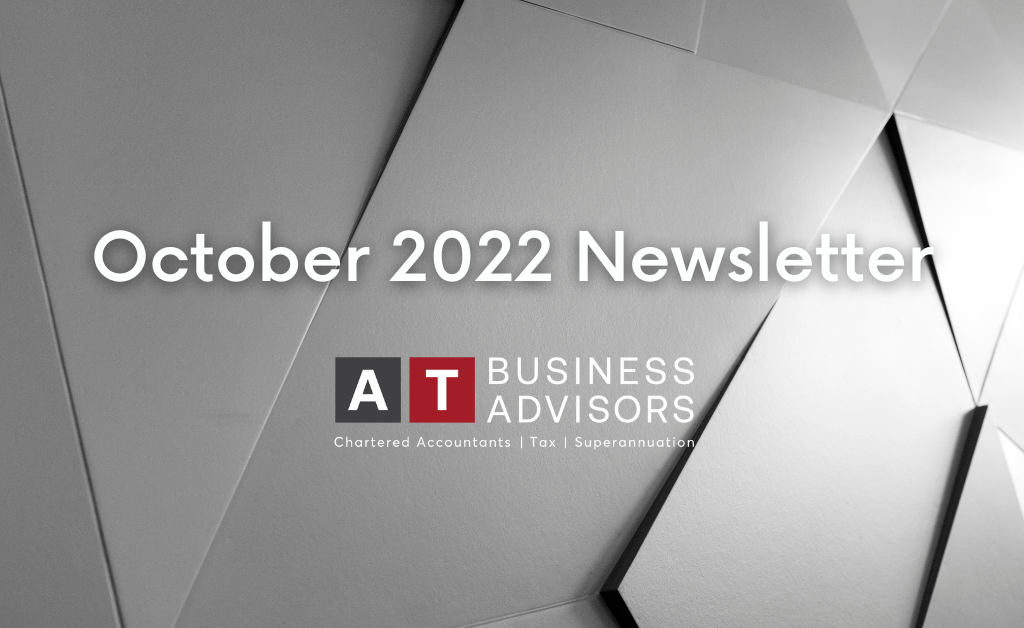COVID downgraded but not gone
National Cabinet agreed to end the mandatory isolation requirements for COVID-19 effective from 14 October 2022. Each state and territory has, or will, implement the end of the isolation rules.
The Pandemic Leave Disaster Payment, the payment to workers who have lost income they needed to self isolate or care for someone with COVID-19, also end on 14 October. The Pandemic Leave Disaster Payment was extended beyond its 30 June end date but restricting the number of times claims can be made in a 6 month period.
While the Pandemic Leave Disaster Payment will end, National Cabinet agreed to continue targeted financial support for casual workers, on the same basis as the disaster payment, for workers in aged care, disability care, aboriginal healthcare and hospital care sectors. Final details of this new payment are yet to be released.
ATO contacts ‘at risk’ professional services firms
New guidelines for professional services firms – lawyers, architects, medical practitioners etc., came into effect on 1 July 2022. The guidance takes a strong stance on structures designed to divert income in a way that results in principal practitioners receiving relatively small amounts of income personally for their work and reducing their taxable income. The ATO is now contacting professionals who they believe might be at risk. Any structural changes that need to be made to reduce risk, should be completed by the end of the 2022-23 financial year. Where the ATO deems that income has been diverted inappropriately to create a tax benefit, they will remove that benefit and significant penalties may apply.
1 October minimum wage increase
Minimum wages in 10 awards in the aviation, tourism and hospitality sectors increased from 1 October 2022. The increase happens from the first full pay period on or after 1 October 2022. See the Fair Work Ombudsman for more details.
Director ID number deadline looming
If you are a Director of a company or registered foreign company and have not applied for your Director ID Number, the deadline is 30 November 2022. Don’t leave it until the last minute!
Australian super funds gorge on cryptocurrency
The value of cryptocurrency assets inside Australian self managed superannuation funds (SMSFs) increased by 589.9% ($1.17bn) between June 2019 and June 2022, according to the latest ATO statistics.
While cryptocurrency is a relatively small asset class at only 0.16% of the $837bn held in SMSFs, it is a growing asset class, larger than collectibles and personal use assets, and overseas property.
Smaller funds, with an asset value below $200,000, are more likely to have a larger proportion of their value in cryptocurrency.
ASIC warns of SMSF cryptocurrency scams
Earlier this year, the Australian Securities and Investments Commission (ASIC) issued a warning on an increase in marketing encouraging Australians to switch from retail superannuation funds to SMSFs so they can invest in ‘high return’ portfolios. The regulator states that crypto-assets are a high risk and speculative investment and best practice is to seek advice from a licensed financial adviser before agreeing to transfer superannuation out of a regulated fund into an SMSF.
An example of one of these schemes was A One Multi Services Pty Ltd that was shut down by ASIC late last year. The company promoted a scheme encouraging investors to roll their superannuation into an SMSF, then for the SMSF to loan money to A One Multi to generate “returns of between 10% and 20% on the investment and perhaps as high as 26%.” Over 60 SMSFs transferred $25 million into A One Multi’s accounts between January 2019 and June 2021. The money “invested” for the clients, between $7 million to $22 million of Bitcoin, was held in the name of one of the directors. An additional $5.7m was used by the directors to acquire property and luxury cars.
Investing in crypto
Trustees are free to invest in assets that meet the requirements of the fund and comply with the regulatory requirements:
- Trust Deed – must allow for cryptocurrency assets. Most SMSF trust deeds are drafted broadly to enable trustees to invest in assets permitted by the superannuation laws and leave the investment strategy to manage the choice of assets and their appropriateness. However, it is important to check.
Investment strategy – With cryptocurrency’s high volatility and risks, there must be clearly articulated information in the Investment Strategy. That is, it must articulate the trustees’ plan for making, holding and realising assets in a in a way that is consistent with the retirement goals of members being mindful of the member’s individual circumstances.
- Separation of assets – cryptocurrency assets must be held in a wallet in the name of the SMSF and the IP address is provided to the SMSF auditors to verify the transactions (against the fund bank account). Problems often arise when a wallet (in the name of the SMSF) is connected to a personal credit card to acquire cryptocurrency. In these cases, the payment may be considered as either a contribution or a loan to the SMSF.
- Sole purpose test – Your SMSF needs to meet the sole purpose test to be eligible for the tax concessions normally available to super funds. This means your fund needs to be maintained for the sole purpose of providing retirement benefits to your members, or to their dependants if a member dies before retirement.

